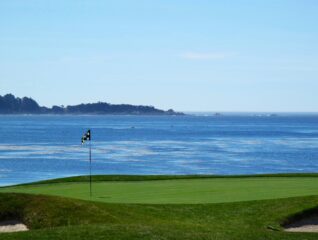 Tired of playing the same eighteen holes every weekend? Then this book is for you. The Golf Bucket List will introduce you to new ways for you to enjoy the game of golf, from the 10 most unique golf experiences you should try, to the 10 knee-knocker tee shots you need to hit, to advice for how to play at the most exclusive U.S golf clubs.
Tired of playing the same eighteen holes every weekend? Then this book is for you. The Golf Bucket List will introduce you to new ways for you to enjoy the game of golf, from the 10 most unique golf experiences you should try, to the 10 knee-knocker tee shots you need to hit, to advice for how to play at the most exclusive U.S golf clubs.
Whether your golf game is on par with the pros or you’ve only just picked up some clubs, The Golf Bucket List is the perfect way to immerse yourself in the world of golf—and have fun while doing it!
Below, check out an excerpt on the best golf courses every golfer should play in the United States.
* * *
Ten Best Golf Courses to Play in the United States
PINEHURST AND THE NORTH CAROLINA SANDHILLS
Had the wee Scottish golf pro Donald Ross not emigrated to the United States and taken up residence in the Sandhills of North Carolina, perhaps the area would still be the barren wasteland it was at the turn of the twentieth century. You could certainly make an argument that without Donald Ross’s imprint, the region around Pinehurst may still have golf, but not the golf it has. Ross was a talented player brought to Pinehurst by the town’s founder, James Tufts, a decision that changed golf not only in Pinehurst but throughout America.
During the 1880s, Tufts, tired of brutal New England winters, used the profits of a successful soda fountain business to head to the warmth of southern places like Florida or the Bahamas. Concerned that working-class New Englanders didn’t have the resources for such a trip, he looked for a place where he could re-create everything rich and charming about New England, minus the winter cold. He was a regular on the north-south train route, getting off at various destinations, until one day in 1895 he disembarked in Southern Pines. He met brothers Henry and J. R. Page, and they cut a deal for 4,703 acres of sandy loam, thick with towering pines but thin on promise. Tufts had just sold his share in the American Soda Fountain Company for $700,000, a pittance of which he used to pay the Pages’ asking price of $1.25 per acre, although some locals said he was swindled, claiming the land was worth only 85 cents an acre.
Tufts, not a robust man physically but quite robust in business, probably didn’t care about the price per acre. He heard the Sandhills had a natural healing quality and was determined to build a town where New Englanders, many of whom suffered from tuberculosis and other ailments, could come to get healthy.
The oddity of the topography of south-central North Carolina—beach-like sand sprouting towering longleaf pine trees—would be otherwise insignificant if it weren’t for the fact that the terrain, like the linksland of the British Isles, is so ideally suited for golf, which was no more in Tufts’s original plan than a 16-story hotel. But Tufts’s love of the wholesome, small-town virtues of New England transplanted into the more hospitable climate of North Carolina would evolve to become one of the world’s great golf destinations.
He commissioned Ross to build four courses at his new resort in Pinehurst, and the young pro found his calling. Today, those four courses, including US Open venue Pinehurst No. 2, remain the centerpiece of golf at the resort that has grown to 10 courses while his work at nearby Pine Needles Lodge and Golf Club, Mid Pines Inn and Golf Club, and Southern Pines Golf Club create the attraction golfers gravitate to, complete with the charm of New England and the hospitality of the South. Thankfully, Ross ventured out from the Sandhills to design courses around the country, including all-time greats like Seminole Golf Club in Florida, Oakland Hills Country Club near Detroit, Oak Hill Country Club in Rochester, New York, Aronimink Golf Club near Philadelphia, Scioto Country Club in Columbus, Ohio, and East Lake Golf Club in Atlanta. In all, Ross designed about 400 courses around the county.
Since his death in 1948, dozens more modern courses have been built to supplement Ross’s Pinehurst classics. Places like Talamore Golf Resort, Mid South Club, Tobacco Road Golf Club, and Legacy Golf Links have all become great complements to the main features. And it all started inadvertently when Tufts lured Ross to what was once considered a sandy, god forsaken wasteland.
SOUTH CAROLINA COAST
If Myrtle Beach is a smorgasbord of cheap seafood restaurants and gentlemen’s clubs, perhaps it’s only because the South Carolina coast needs a balance to the abundance of classy establishments of Charleston and Hilton Head Island. I’m not knocking Myrtle Beach, I’m just saying it’s different. Clearly, its formula for drawing groups of golfers year-round has worked for decades. It is time-tested and proven, and without Myrtle Beach, American golf would lose a major appendage. But the entire coast of the Palmetto
State is an attractive destination to the golfing population of the Northeast, Canada, and beyond.
Along the Grand Strand, which includes the entire Myrtle Beach area and even spills into southern North Carolina, there are more than 80 courses, although that number is down from more than 100 at Myrtle Beach’s peak at the beginning of the century. Those left in the culled herd are largely the ones proven to be the best over the decades, from the historic Pine Lakes Country Club, which opened in 1927 as the first course in the beach resort area, to the wonderful Dunes Golf and Beach Club designed by Robert Trent Jones in 1949, to modern gems like the four courses at Barefoot Resort and Golf and the Mike Strantz–designed Caledonia Golf and Fish Club. The Grand Strand’s deep bench, improving food scene, and always prevalent nightlife keeps it among the world’s greatest golf destinations.
The southern extreme of the Grand Strand almost melts into the northern reaches of Charleston, and if there is a classier city, I haven’t been there. Charleston teems with history, museums, fine dining, beaches, and a downtown area with something interesting on every corner. Even the golf seems to be more stylish than in most cities.
That’s largely thanks to three islands:
• Kiawah Island is famous for its Ocean Course, which hosted the famous “War by the Shore” Ryder Cup in 1991, and its four supporting layouts are outstanding as well.
• Seabrook Island is more subdued and home to the Robert Trent Jones–designed Crooked Oaks and the more modern Ocean Winds, both of which roam through marsh, maritime forests, and centuries-old moss-hung oaks.
• On the Isle of Palms, the Links Course at Wild Dunes Resort rolls through dunes to the climatic oceanside finish. The Harbor Course isn’t quite as wild but a fun routing nonetheless.
The mainland is anchored with courses like Dunes West Golf Club, RiverTowne Country Club, and the Links at Stono Ferry. And if there’s any way you can possibly finagle a starting time at the private Yeamans Hall Club, you won’t be disappointed by the reinvigorated Seth Raynor design from the 1920s.
Everything is considerably more modern on Hilton Head Island. It was 1969 when Jack Nicklaus helped a former insurance salesman from Indiana clear golf holes through the maritime forests of the island to create Harbour Town Golf Links at the Sea Pines Resort. It became a classic almost from the time the first tee shot was hit. The Professional Golfers’ Association of America (PGA) Tour event now known as the RBC Heritage has been played on the course since its opening. Much of the rest of the land on the island, which is a little more than half the size of Nantucket, is crammed with 29 courses and there’s not a slouch among them.
THE MONTEREY PENINSULA
Hindsight being what it is, I now realize it was a mistake for me and three friends to fly across the country two days after New Year’s Day for a tee time at Pebble Beach. The post-holiday crowds at the airport and the burden on the airlines to get everyone home caused lengthy delays I should have anticipated. Of course, it was my own fool self that booked a flight into San Francisco when San Jose is the appropriate and closer airport to the Monterey Peninsula. It all added up to a late-night landing, rental car fiasco, and drive into the small hours of the morning to a cheap hotel in Carmel-by-the-Sea.
I can’t remember the name of the hotel, but there was some sort of tree involved, and approaching 2 a.m., it was finally in sight when the lights on the sign flickered out. By the time we’d negotiated the last traffic light and pulled up to the lobby door, it was dark inside and locked up tight. Unsure what to do, we drove a full lap around 17 Mile Drive, pulled into the parking lot at Pebble Beach, and tried to get some sleep.
I’m quite sure it’s not among Fodor’s travel tips to spend the night before your tee time at one of the world’s most famous courses, hoping sleep will come in the bucket seat of a rental car. Fortunately, the rest of the trip went well. We got Pebble Beach on a glorious blue-sky day, and I made par on all of its seaside holes except at No. 8, where I made an “X.” Spyglass Hill was the surprise of the trip.
A course just up 17 Mile Drive from Pebble and Cypress Point is no afterthought, and the Links at Spanish Bay is a surprisingly delightful nature links along the Pacific.
It will be among the most expensive bucket list trips you make, but these days that’s the norm with bucket lists.
BANDON DUNES GOLF RESORT
We East Coasters who are all privy to at least one major international airport can fly to the British Isles as quickly as we can get to the Bandon Dunes Golf Resort. So the question was always, “Why trade authentic links golf for an American impersonation?” But when you get to Bandon Dunes, you’ll realize this isn’t an impersonation of the linksland courses where the game began. It’s true, pure, American links golf. It’s a different ocean and a different style, but it’s not hard to argue that it’s every bit as good. If the soul of the game belongs to Scotland, the definition of what it inspires is found along this stretch of the Oregon coast.
The massive resort includes six courses that, like the great British Isles links, live in harmony with the land. Catch the sixteenth of the Bandon Dunes course on a clear late afternoon as the sun sets over the Pacific, and you’ll know why you travel to play the game.
The Sheep Ranch course has nine oceanside greens. Pacific Dunes may be the most natural of the courses, with fairways that roll and greens that fit perfectly among the sometimes-massive dunes. The Old Macdonald course, a tribute to the great classic-era designer Charles Blair Macdonald, celebrates classic design concepts and pays tribute to the traditions of the game. Bandon Trails works its way from atop a massive dune into maritime forests and back into the dunes. Bandon Preserve is a 13-hole par-3 course.
Other courses call themselves links courses, but they are the impersonators, mere attempts to copy what the game looks and feels like in its ancestral home. They always fall short. But Bandon Dunes, four hours south of Portland, is different. It makes no effort to be like anything other than Bandon Dunes. You can go expecting a taste of the old-world courses, but that’s not what you’ll find. If there is more scenic beauty in American golf, I haven’t come across it.
BIG CEDAR LODGE
The most famous hillbilly other than the Hatfields and McCoys struck it rich in the Ozark Mountains, and his kinfolk said, “Jed, move away from there.” So, he moved to California. Johnny Morris struck it rich in the Ozarks and decided to stay, and golfers are thankful his kinfolk didn’t make the same suggestion. The Bass Pro Shop founder didn’t move to Beverly (Hills, that is). Instead, he poured some of his billions into grandeur and golf at the Big Cedar Lodge, where the luxury is the antithesis of the Clampetts’ pre-oil-strike Ozark lifestyle.
Few who get into golf development have Morris’s resources (Forbes estimates his wealth at $8 billion). He went out and got Tiger Woods to design the flagship course at Big Cedar Lodge. Payne’s Valley is the first public-access course created by Woods’s design firm, but all five of Morris’s courses at the resort are so spectacular that in just a few years this wilderness resort in the United States’ only rugged terrain between the Appalachians and the Rockies has become one of the world’s best. Each course was built by a marquee designer and blends into the timberland here much more easily than the Clampetts blended into Beverly Hills. In addition to Woods, Jack Nicklaus, Tom Fazio, Ben Crenshaw, Bill Coore, and Gary Player have worked Morris’s Ozark land into the marquee courses of Branson, Missouri, which has become known as one of Middle America’s best golf destinations.
Morris began his road to fortune as a kid selling bait and tackle out of the back of his father’s liquor store, and he’s always been keen on connecting people with nature. Golf is one way, but so is fishing in the creeks and lakes deep in the Ozarks and a lengthy list of other outdoor activities. Indoors, Big Cedar is one of those opulent no-detail-overlooked places without being ostentatious. So, after a day on the courses, there is plenty of pampering to be done inside.
If golf were bubblin’ crude, this would be the place to drill. Sit a spell, take your shoes off, and have a heapin’ helpin’ of Morris hospitality.
Y’all come back now, y’hear?
NORTHERN MICHIGAN
When a man buys a piece of land, with it comes the right to call it whatever he wants. So, if Everett Kircher wanted to call his 552-foot vertical drop a mountain, even though in the alpine world that’s more of a molehill, then so be it. It was 1947 when Kircher bought his “mountain” in Northern Michigan for $1, giving it a place alongside the Louisiana Purchase and Manhattan as one of the greatest land deals of all time. He bought the mountain with the intent of introducing skiing to the area, and he did. In fact, Kircher became an innovator in the ski world, leading the way in snowmaking in the 1950s and in chairlifts over the next few decades.
But snow melts and skiing go dormant in the summer, even farther north than the frozen tundra of Green Bay. So Kircher climbed aboard his father’s aging Ford farm tractor and tilled up a ninehole golf course he called Hemlock. That sufficed for a while, but as interest in golf during Northern Michigan’s short summers grew, the region needed more. Kircher built more at his Boyne Resort, which now includes 10 fine courses over three separate resorts. But others also recognized the opportunity, even if last call on the golf season is a couple weeks before Halloween. Golf exploded around the small town of Gaylord, where the Gaylord Golf Mecca includes Treetops Resort with its four great courses and one of the best par-3 courses in the country; four courses at Garland Lodge and Golf Resort, and two at Ostego Resort. Traverse City is the “Cherry Capital of the World,” but the pickings for golf aren’t too slim. Shanty Creek Resort has five courses, Grand Traverse Resort and Spa has three. The treat of Northern Michigan is Forest Dunes Golf Club, a 36-hole course built on sand dunes in the middle of the state.
The whole of Northern Michigan is knitted together by a plethora of small-town courses, some public, some private, but all wonderful experiences. The granddaddy of them all is the exclusive Crystal Downs Country Club, on a bereft piece of land between Lake Michigan and Crystal Lake. It may be nowheresville, but the course is ranked alongside Winged Foot Golf Club, Pebble Beach, Muirfield Village Golf Club, and Los Angeles Country Club. Don’t turn down an invitation.
ALABAMA’S ROBERT TRENT JONES GOLF TRAIL
Sometime in the late 1980s, David G. Bonner, CEO of the Retirement Systems of Alabama, had this outlandish idea to diversify the fund’s assets by investing in golf. His thought, that investing in Alabama would mean a stronger Alabama retirement system. But golf?
What seemed like an off-the-deep-end idea wasn’t just to build a golf course, but to build 378 holes of golf on eight sites across the state. And he didn’t want to build them one at a time. So, sometime in the early 1990s a brigade of bulldozers started reshaping land around the Heart of Dixie into golf courses. Like many great innovators, he was ahead of his time. But if some slightly off-center guy in Iowa could build a baseball field to drive tourism, maybe golf could do the same thing for Alabama. And it did.
By the late 1990s golfers were pouring into the state to play golf on the Robert Trent Jones Golf Trail. These weren’t run-of-themill layouts; they were designed by one of the game’s great course designers on sites with spectacular terrain that appeared made for golf. And they were built to a scale beyond what was appropriate for the day, some stretching more than 8,000 yards. Golfers loved them, so they built more. Now, in the 384 miles between The Shoals in northwest Alabama and Lakewood Golf Club on Mobile Bay almost to the Gulf of Mexico, the unique trail of golf courses includes more than even Bonner imagined. There are 11 sites along the trail, some of which include hotels, luxury resorts, spas, restaurants, and residential developments. There are 26 courses (468 holes) on differing sites, each its own masterpiece carved from hills, valleys, marshes, and flatlands to provide a much wider variety of experiences than other destinations.
Some of the courses are named after geographical features, like the three at Hampton Cove (Highlands, River, and Short). Others make you wonder what you’re getting yourself into—Fighting Joe and Schoolmaster at The Shoals or Mindbreaker, Heartbreaker, and Backbreaker at Silver Lakes. Others just pay tribute to their location, like the Legislator, Senator, and Judge courses of Capitol Hill just north of Montgomery.
More than half a million rounds are played every year on the trail, many by golfers outside Alabama, who spend their money not just on green fees but in hotels, restaurants, and shops. It all spurs Alabama’s economy and ensures the state’s pension fund will provide retirees everything it promises.
THE SOUTHWEST DESERT
After years of winging our way to Florida for the annual respite from the brutalities of a Northeastern winter, my aging group decided we were getting too old to constantly fight the wind and the threat of rain, meaning we’d have to hang around the hotel together (entirely unacceptable). The Sunshine State doesn’t always live up to its billing in January. Someone suggested the desert.
The flight is longer and the time change is annoying, but the courses have more geographic interest, with fairways lined by desert rather than the water and condominiums of Florida.
In the desert, maybe you can’t remember your name, but you can certainly forget winter. That first year, we booked tickets to Palm Springs, which averages 350 days of sunshine each year. Streets in Palm Springs run due north-south or due east-west, sectioning the Coachella Valley into boxes like your Super Bowl betting grid. Some boxes are bigger winners than others. One square at the intersection of Frank Sinatra Drive and Bob Hope Drive contains Rancho Mirage Country Club. Another contains Desert Willow Golf Resort.
Many contain exclusive private clubs in this fashionable resort area that became a celebrity escape from Los Angeles. The squares start to fall apart as they nudge up to the Santa Rosa Mountains, and the golf gets even better at courses like Indian Wells Golf Resort and PGA West, an annual stop on the PGA Tour.
In case you haven’t noticed flying over these states, the Southwest desert is vast, and though golf plays just a small role in it, there are many green oases. Scottsdale is a hotbed for trendy shops, restaurants, and upscale resorts where course designers have creatively used the desert as hazards between holes and as forced carries to get from fairway to green at outstanding courses like Greyhawk Golf Club, Quintero Golf Club, and We-Ko-Pa Golf Club.
Las Vegas is known for its nightlife, but there are plenty of daylight hours to idle away, and the golf can be awesome. Shadow Creek Golf Course and Wynn Golf Club are two of the most expensive courses in the world to play, and while they will be two of the best you will ever play, whether they’re worth the price is up to you. There are plenty of more affordable courses around town and in other desert destinations like Mesquite, where courses like Falcon Ridge Golf Course and Wolf Creek Golf Club showcase the drama of the desert rolling right up to the edge of the playing surfaces.
The weather, scenery, outstanding courses—I’ve found many reasons to love desert golf.
DESTINATION KOHLER
Had things gone slightly differently, the spectacular land alongside Lake Michigan that Pete Dye bulldozed into one of the country’s greatest golf courses would be churning out nuclear power instead of triple bogeys. The property just north of Sheboygan was an abandoned airfield when Wisconsin Electric bought it in the 1970s and proposed the Haven Nuclear Power Plant. Local residents opposed the idea of generating great power along this great lake, and so the land’s owner eventually gave up and sold the land to the Kohler Company, the iconic plumbing-products company founded by John Michael Kohler in 1873 that is still in the Kohler family.
It’s hard to find a path from faucets to world-class golf, but Herbert Kohler, grandson of the founder, plumbed his way to a four-course destination. The marquee course, rugged and windswept Whistling Straits, has held two PGA Championships, the United States Golf Association (USGA) Senior Open and the Ryder Cup, making it one of just a few US courses open to the public on which the Ryder Cup has been played. The course is built along two miles of the Lake Michigan shoreline, exposing your shots to the sometimes-brutal weather that has caused more than 600 shipwrecks on the lake. It’s sibling, the Irish Course, is a more manageable inland layout, another Dye design that while much less decorated is still a worthy resort course. The 36-hole Blackwolf Run property, which has twice hosted the US Women’s Open, is also part of Destination Kohler.
More than just golf, the Kohler experience includes spas, fine dining, five-star hotels and remote cabins, and plenty of après-golf activities. But the draw is to play the Straits Course, which has taken down some of the best players in the world like a ship in a storm.
HAWAII: KAPALUA GOLF CLUB
If any of our states were a bucket-list destination—golf or otherwise—it would be Hawaii. Yes, it’s overdone and over-commercialized, but isn’t just about everything in golf?
The Plantation Course at Kapalua Golf Club is one of the country’s best courses open to the public, and we see it every January on television, as the PGA Tour opens each season with the Tournament of Champions. Built on the slope of the 5,800-foot Puʻu Kukui mountain, we watch every year as drives roll down steep fairways for 25 seconds, ending up sometimes more than 400 yards from where they were struck.
The course was built in the early 1990s but often has the feel of a classic Northeastern layout. You’ll never confuse it for that, as you’ll spend much of the round gazing out over the blue Pacific hoping to catch a glimpse of a whale in the distance. There are plenty of downhill shots to make you feel like a big hitter. It’s a big course with wide fairways to accommodate the wind and excessive roll, but there is still plenty of opportunity to hit a shot off the playing surface and into trouble among the trees and scrub brush of the craggy volcanic bluffs. Along the way you’ll find a punchbowl green and bunkering that resembles early-US course architecture.
The Bay Course at the resort is a much more manageable challenge, but this is Hawaii. There are ocean beaches to bask on, cuisine to enjoy, whales to watch, and waterfalls to discover. And if you’re the serious adventurer, you can venture up 10,000 feet to the summit of Mt. Haleakalā for the jaw-dropping beauty of the sunrise. But don’t forget the golf.
* * *
How many of these courses have you played? For more ideas on how to make the most of your golf experiences, check out The Golf Bucket List by Jeff Thoreson, available now!























 Celebrate Kamala Harris, the first female Vice President
Celebrate Kamala Harris, the first female Vice President 









 Did you touch that TBR pile yet?…. Get to it and have this romantasy coloring book next to you! Featuring 24 illustrations inspired by all the best parts of romantasy books, this captivating collection will have you bringing mythical creatures, magical landscapes, and ethereal characters to life through color.
Did you touch that TBR pile yet?…. Get to it and have this romantasy coloring book next to you! Featuring 24 illustrations inspired by all the best parts of romantasy books, this captivating collection will have you bringing mythical creatures, magical landscapes, and ethereal characters to life through color.





















 Tired of playing the same eighteen holes every weekend? Then this book is for you.
Tired of playing the same eighteen holes every weekend? Then this book is for you. 









